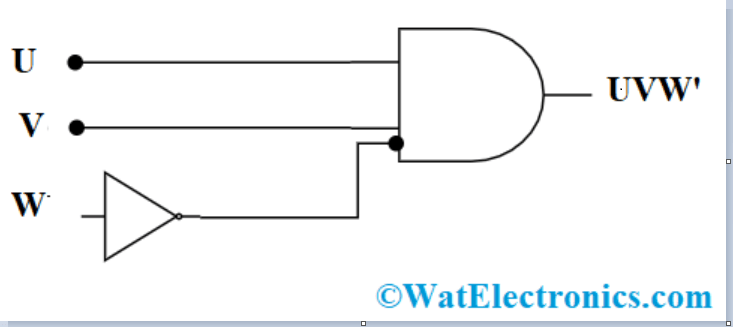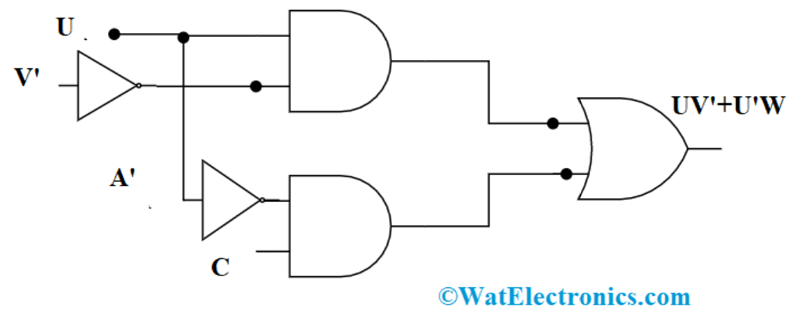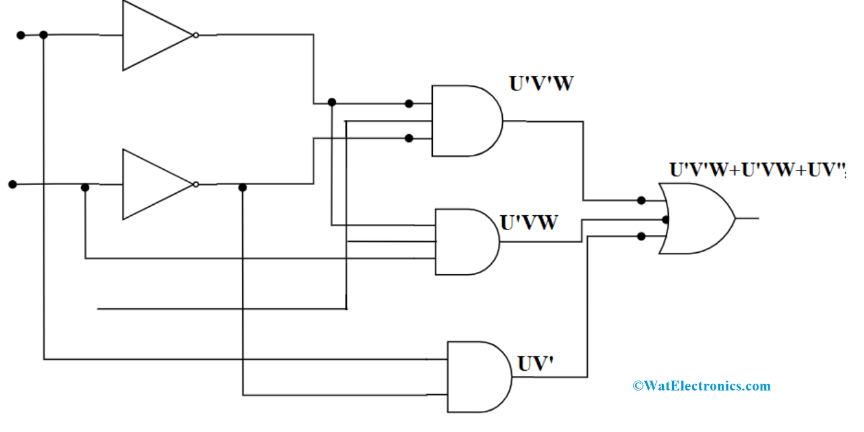Initially, we are only with the propositions of true and false and these bivalent values introduced four laws of logic. But in many of the situations, there might be a need of more than these two values, in that case, the bivalent solution fits in. This bivalent approach is proposed by Aristotle. Making modifications to his approach George Boole founded Boolean Algebra which categorized multiple laws of relationship those are in between mathematical quantities constrained to one of two values: 1 or 0 (or) true or L. But one might be in the confusion that how only those values will be valued either in a calculator or to compute current flow in the resistor. So, let’s move on with the concepts of what is Boolean Algebra and its principles, laws, and properties.
What is Boolean Algebra?
Boolean Algebra, which is also called as ‘Switching Algebra’ or ‘Logical Algebra’ uses the two variables ‘1’ and ‘0’ to evaluate and simplify the logical values. It works on various functions of logical values and integrates binary variables. Being so different from the binary operations which are performed through addition and multiplication operators, Boolean structure works with meet and join operators. We already discussed that Boolean Algebra works only with “0” and “1”, but a single expression might have many numbers of variables where all are individually represented as inputs for the expression.
Boolean Algebra Rules
As Boolean algebra is mostly implemented in the scenario of logic circuits simplification and to do this, there are certain rules to be followed. The rules are stated as below:
• Expressions can be simplified only through two values 1 to represent true state and 0 to represent the false state.
• Any variable complement needs to be represented by a (-). For example, the complement of B is desired as B’. So, when B is H, B’ is L and when B is L, B’ is H.
• A ‘+’ sign is used to perform OR operation on variables. To perform OR of three variables (X, Y, and Z), it is desired as X + Y + Z.
• A ‘.’ (Dot) sign is used to perform AND operation on variables. To perform AND of three variables (X, Y, and Z), it is desired as X.Y. Z (or) it can be XYZ and the dot can be ignored.
Laws of Boolean Algebra
Each of the laws that are going to be stated below is given with either with one or two variables, but the number of variables specified by a single law is constrained to this because an expression may contain many numbers of variables as inputs. So, Boolean algebra laws can represent any kind of complicated expression in the digital circuitry. The laws are:
- Commutative law – It states that changing of operands order will produce the same result either in OR or AND operation.
X + Y = Y + X and X.Y = Y.X
- Associative law – This law states that when AND or OR operations are performed on any group of variables, the result is the same.
X + (Y + Z) = (X + Y) + Z and X. (Y.Z) = (X.Y). Z
- Distributive law – This law states that when multiplication is performed first and added with a variable will produce the same result as multiplying the addition of two separate variables.
X. (Y + Z) = (X.Y) + (X.Z) and X + (Y.Z) = (X + Y). (X.Z)
- Annulment law – This states that when a variable is ANDed with ‘0’ produces ‘0’ and ORed with ‘1’ produces ‘1’.
X.0 = 0 and X+1 = 1
- Identity law – This states that when a variable is either ORed with ‘0’ or ANDed with ‘1’ results in the same variable.
X + 0 = X and X.1 = X
- Idempotent law – A variable that is either ANDed or ORed with the same variable results in the same input variable.
X + X = X and X.X = X
- Complement law – A variable ANDed with its complement results ‘0’ and ORed with its complement results ‘1’.
X. = 0 and X + = 1
- Double Negation law – A variable when complemented twice produces the same result as input.
((X)’)’ = X
- Absorption law – This law can be applied to simplify the complicated expressions.
X + (X.Y) = X and X. (X+Y) = X
Theorems in Boolean algebra
In addition to the operation of variables as per the rules and laws, there are theorems in Boolean algebra where the system is mainly based upon. Those theorems are
• De Morgan’s theorem
• Consensus theorem
• Shannon’s expansion theorem
De Morgan’s Theorem
This law mainly works on the principle of ‘Duality’. Duality corresponds to an interchange of variables and operators in an expression. It means in the sense that interchanging of H with L and L with H.
To solve the algebraic expressions, De Morgan’s law is expressed as two statements
Statement 1: (X.Y)’ = X’ + Y’
Statement 2: (X + Y)’ = X’. Y’
Statement 1: Truth table
| X | Y | X’ | Y’ | X.Y | (X.Y)’ |
X’ + Y’ |
|
L |
L | H | H | L | H | H |
| L | H | H | L | L | H |
H |
|
H |
L | L | H | L | H | H |
| H | H | L | L | H | L |
L |
The expressions through De Morgan’s law are easily simplified by tabulating a truth table and it is given below
Statement 2: Truth table
|
X |
Y | X’ | Y’ | X + Y | (X + Y)’ |
X’.Y’ |
|
L |
L | H | H | L | H | H |
| L | H | H | L | H | L |
L |
|
H |
L | L | H | H | L | L |
| H | H | L | L | H | L |
L |
De Morgan’s theorem can also be implemented through logic gates by using AND and OR gates.
For Statement 1: logic diagram

de morgan statement 1
For Statement 2: logic diagram

de morgan statement 2
Consensus Theorem
Consensus theorem can be explained in two statements one in normal method and the other is the dual method. It states that consensus terms of the disjunction are specified when the terms in the expression are complements to each one like X and X’. The two statements are
Statement 1: UV + U’W + VW = UV + U’W
Statement 2: (U + V) (U’ + W) (V + W) = (U + V). (U’ + W)
Statement 1: Truth table
| X | Y | Z | XY | X’Z | YZ | UV + U’W + VW | UV + U’W |
|
L |
L | L | L | L | L | L | L |
| L | L | H | L | H | L | H |
H |
|
L |
H |
L | L | L | L | L | L |
| L | H | H | L | H | H | H |
H |
|
H |
L | L | L | L | L | L | L |
| H | L | H | L | L | L | L |
L |
|
H |
H | L | H | L | L | H | H |
| H | H | H | H | L | H | H |
H |
The expressions through Consensus law are easily simplified by tabulating a truth table and it is given below
Statement 2: Truth table
| X | Y | Z | X+Y | X’+Z | Y+Z | (U + V) (U’ + W)
(V + W) |
(U + V). (U’ + W) |
|
L |
L | L | L | H | L | L | L |
| L | L | H | L | L | H | L |
L |
|
L |
H | L | H | H | H | H | H |
| L | H | H | H | L | L | L |
L |
| H |
L |
L | H | L | L | L |
L |
|
H |
L | H | H | H | H | H | H |
| H | H |
L |
L |
L | H | L | L |
| H | H | H | L | H | L | L |
L |
Shannon’s Expansion Theorem
This theorem is implemented to expand the Boolean expression regarding a single operator.
f (X1, X2, X3…. Xi…..Xn) = Xi. f (X1, X2, X3, …..1…..Xn) + Xi’ (X1, X2, X3…….0.,…..Xn)
For example, it can be explained as
f(U, V, W, X, Y, Z) = W .f(U, V, 1, X, Y, Z) + W’. f(U, V, 0, X, Y, Z)
In the same way theorem 2 can be stated as
f (X1, X2, X3…. Xi…..Xn) = [Xi+ f (X1, X2, X3, ……..Xn)] . Xi’ + (X1, X2, X3…….1.,…..Xn)]
For example, it can be explained as
f(U, V, W, X, Y, Z) = [W + f(U, V, 0, X, Y, Z) . [W’+ f(U, V, 1, X, Y, Z)]
Examples
The examples of Boolean algebra can be derived through
• Truth tables
• Boolean expression simplification
• Logic gates
Examples
- UVW’
| U | V | W | W’ | UVW’ |
|
L |
L | L | H |
L |
| L | L | H | L |
L |
|
L |
H | L | H | L |
| L | H | H | L |
L |
|
H |
L | L | H | L |
| H | L | H | L |
L |
|
H |
H | L | H | H |
| H | H | H | L |
L |

boolean algebra example 1
- U + V’W
| U | V | W | U + V’W
|
|
L |
L | L | L |
| L | L | H |
H |
|
L |
H | L | L |
| L | H | H |
L |
|
H |
L | L | H |
| H | L | H |
H |
|
H |
H | L | H |
| H | H | H |
H |

boolean algebra example 2
- UV’ + U’W
| U | V | W | UV’ + U’W
|
|
L |
L | L |
L |
| L | L | H |
H |
|
L |
H | L | L |
| L | H | H |
H |
|
H |
L | L | H |
| H | L | H |
H |
|
H |
H | L | L |
| H | H | H |
L |

boolean algebra example 3
- U’V’W + U’VW + UV’
| U | V | W | U’V’W + U’VW + UV’
|
|
L |
L | L | L |
| L | L | H |
H |
|
L |
H | L | L |
| L | H | H |
H |
|
H |
L | L | H |
| H | L | H |
H |
|
H |
H | L | L |
| H | H | H |
L |

boolean algebra example 4
Applications
The applications of Boolean algebra can be in any domain where the variable has two conditions. Below are the few real-life examples in Boolean Algebra:
- An automated cafeteria machine that dispenses either coffee, milk or tea. Here every drink is presented in two conditions either to dispense (‘1’) or not dispense (‘0’). The output is the selection of either of the ones from the three choices.
- In the application of U.S rocker launcher, the logic behind Boolean algebra is implemented. It has a president’s button and the three counselor’s buttons, and these are considered as inputs. The output is ‘1’ (missile fire) when the below conditions are true
• Either of the counselor’s push the button and
• President and either of the counselor has to push the button
The other applications are in two-floor elevator, calculators, watches, seven-segment displays, digital clocks, electronic circuitry, and many others.
So, we are with the conclusion that Boolean numbers are completely different from the real numbers and it is a different kind of mathematics. As because of extensive applications and uses, Boolean algebra holds great prominence. So, know how Boolean Algebraic expressions are implemented?
Please refer to this link to know more about De-Morgan Theorem MCQs.
FAQ’s
1. What is the use of Boolean algebra?
The main purpose of Boolean algebra is to evaluate and simplify the complicated logic circuits. With the use of binary numbers ‘1’ and ‘0’, the system performs many functions.
2. How do you calculate Boolean algebra?
Boolean algebra is computed through the assistance of rules, laws, and properties. And with the help of truth tables, Boolean expressions are derived and through the expressions, logic gates are drawn. These logic gates give a detailed description of what a Boolean expression is.
3. How Boolean algebra is different from algebra?
In general algebra, it can consider many numbers of values as inputs, while in Boolean algebra it considers only ‘1’ and ‘0’ as inputs. There exists numerical implication for variables in ordinary algebra and in Boolean algebra it has logical implication for variables.
4. What is Boolean logic?
Boolean logic is mainly considered as the core of evaluating expressions and this logic is performed with the logic gates “AND”, “OR” and “NOT”.
5. What is an example of a Boolean?
For example, when the input (expression) is considered as “6>3”, the output in the Boolean logic is ‘1’. Because 6 is greater than 3 and it is true. So ‘1’ is represented for true and ‘0’ for false.